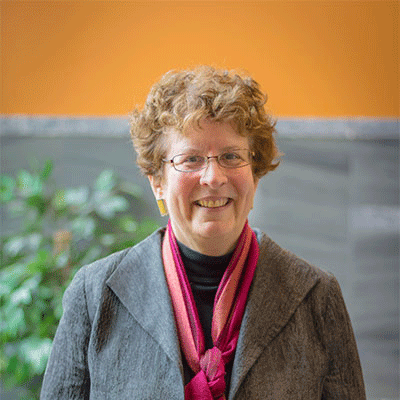President Elaine Collins offers optimism, hope for NVU’s future

NVU President Elaine Collins
On Tues, Nov. 5, NVU President Elaine Collins gave the President’s State of the University Address to a crowd in the Stearns Performance Space of mostly faculty and staff.
An invitation email for the event from Darcie Miles said, “President Collins will discuss the past year at NVU, including key areas of focus for the future. Following her talk, President Collins will respond to questions.”
Faculty and staff started pouring in for the meeting, but only two students showed, a Basement Medicine reporter and theater major Reanna Jean Adams. Chancellor Jeb Spaulding was also present for the address.
Collins stood at the podium and presented a PowerPoint presentation.
“I’m pleased to welcome you all here today to take stock of the progress that we have made on a variety of initiatives undertaken this past year as well as to look out into the future of Northern Vermont University in its second year and beyond,” said Collins. “Many of you have asked me over time where I find inspiration to continue leading in this stressful time. And simply put, my inspiration comes from all of you, the members of this community and the members of this campus. From you, I’m uplifted every day, by your willingness to always go beyond and above and beyond for our students and for each other and for our institution.”
Collins spoke about many topics concerning the first few years of the unified institution, including the achievements made across the board. Among these were the new telepresence rooms and Bentley road and lot repaved on campus. Externally, the signage in town and social media presence online were revamped and revisited to uphold the tenet of “a vibrant, thriving campus.”
She revisited again and again our need for oneness and cohesion as the first years of the institution fall into place, especially after showing budget and deficit numbers for the past fiscal year. “Please remember NECHE does not expect to see us fully balanced until 2023,” Collins said. “But we must continually demonstrate progress towards a balanced budget.”
Collins showed slides with many different charts showing the difference between the three previous years and the first two of NVU. Statistics included percentages of underrepresented groups, first-generation students and graduation rates among them.
Retention rates seemed to be chaotic for the years shown, which included 2016-present. From 2016 to 2019, the retention rates were 67.9%, 63.9%, 66.2% and 63.4% respectively.
Collins addressed the spreading misinformation which caused the frustration earlier this semester at Lyndon’s White Paper presentation. “Conversations with alumni groups continue to take place to correct misinformation. Let me just stop here and say this. It’s really important that any unfounded rumors that you hear be stopped by any individual in this community, so that we can continue to share with others information that is factually accurate.”
Collins also spoke about new innovations in academic areas, such as the new Writing, Editing and Publishing program in the English department, and three new interdisciplinary degrees under the new organizational Schools. As well, NVU introduced an online M.A. in Professional Studies.
She showed slides of academic achievement by singular students, along with profiles of excellent athletes.
To close, Collins said, “I look forward to working with each of you to increase and leverage the efficiency, effectiveness and collective strength of our two campuses. As we continue to advance our strategic plan, let’s continue to dream big, and to pursue forward movement relentlessly. Let’s not let the current challenges discourage us. But let’s work together to find new solutions. I thank you for your support for caring for our students, for our community, for your dedication and commitment to the NVU mission.”
After her talk, Collins opened the floor up to questions. Ken Leslie, professor of fine arts, asked, “Along the lines of fake news, where is the info center, like our Snopes? Where could we take these rumors and get a full, satisfying answer?”
After a brief discussion, Leslie was encouraged to take the rumors to Sylvia Plumb in the Communications department.
Other questions included clarifiers from the presentation, as well as more pointed statements about internal communication. Gina Mireault, professor of psychology, asked about retention data for telepresence courses. Provost Nolan Atkins said that currently, “we only track retention by major.”
After a question from the reporter about the library, which is closed completely on Saturdays, Atkins replied that although there is no definitive timeline for when the library will be open again, having that available is “something we certainly strive for,” he said.
In response, another person asked, “What happened with the work/study?”
Sharon Scott, dean of administration, explained that, last May, departments were given their new budgets for hiring work/study students. Many waited until the start of the new semester to analyze their budgets and realized they did not have the money to rehire some students. As such, many were laid off.
Even though there was an increase in direct-hire moneys, the University had to equally portion it across both campuses. Because Lyndon had more direct-hire workers, they had to ration it across, according to Scott. This meant that, on the Johnson campus, both work/study and direct-hire workers were both cut.
Kathleen Brinegar, associate academic dean and professor of education, asked about internal communications such as emails or important memos.
This sparked a conversation about the number of students in the packed room (two) and why administrative events and important information isn’t being disseminated to the student body. “I’m not totally sure what the answer is,” said Adams, admitting that she often ignores emails from the Executive team. “I don’t know if there’s a different way that we can engage students to come to these things.”

Senior, Journalism & Creative Writing
Grew up in Atkinson, NH
Fall 2018
Along with traditional journalism, I enjoy writing satire and fun feature...


